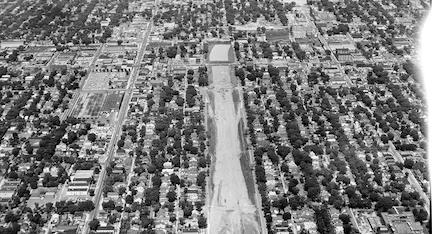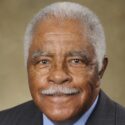 After the passage of the Federal Aid Highway Act of 1956, a massive public works effort went into constructing the nation’s interstate highway system. Today the system includes more than 48,000 miles of highways.
After the passage of the Federal Aid Highway Act of 1956, a massive public works effort went into constructing the nation’s interstate highway system. Today the system includes more than 48,000 miles of highways.
When constructing the system through urban areas, planners often chose routes that went through the poorest and predominantly Black neighborhoods. It was cheaper to obtain property in these neighborhoods and planners believed they would meet minimal resistance from residents and political leaders in these areas.
Greg Donofrio, an associate professor of historic preservation and public history in the School of Architecture at the University of Minnesota, is conducting research on interstate highway construction in the Twin Cities area. Rondo — a primarily Black neighborhood in St. Paul was demolished in the late 1950s and early ’60s to make way for the I-94 freeway. The middle-class neighborhood of Bryant in South Minneapolis was cut in two by the construction of Interstate 35. In 1960, the areas where these interstates were built were home to about 80 percent of the Twin Cities’ Black population.
Thousands of African Americans who lived in these houses and apartments that were in the path of the new interstates lost their homes. People who rented their homes were not compensated at all. Those who owned often felt they were compensated poorly, and there was no assistance with moving expenses or with finding a new home.

Dr. Donofrio and graduate students at the University of Minnesota have created an oral history and research project entitled “A Public History of 35W.” The research is ongoing to document the many ways in which the freeway has had long-term public health and wealth impacts for people living along its path through the city.
 Researchers credit Dr. Ernest Lee Lloyd with providing the initial research. His 2013 doctoral dissertation at Hamline University in St. Paul was entitled “How Routing an Interstate Highway Through South Minneapolis Disrupted an African American Community.” Dr. Lloyd was the son of sharecroppers. He earned a bachelor’s degree at St. Augustine’s University in Raleigh, North Carolina and later added a master’s degree in history to his resume. He worked at the Minnesota Department of Transportation before beginning his doctoral studies.
Researchers credit Dr. Ernest Lee Lloyd with providing the initial research. His 2013 doctoral dissertation at Hamline University in St. Paul was entitled “How Routing an Interstate Highway Through South Minneapolis Disrupted an African American Community.” Dr. Lloyd was the son of sharecroppers. He earned a bachelor’s degree at St. Augustine’s University in Raleigh, North Carolina and later added a master’s degree in history to his resume. He worked at the Minnesota Department of Transportation before beginning his doctoral studies.












This study, like many others on the same subject, is mostly about stoking grievance politics.
Moreover, I do NOT believe it is true to say that African Americans were denied compensation when they were evicted to make way for the interstate highway. For example, many of them could have made, and presumably did make, claims on their tax returns to offset the losses they suffered.
I appreciate this study – more evidence to support oral historians.
Mr. Archer: A Public Study of 35W is a heavily documented, first rate piece of scholarship. No one who has read the study could agree your conclusion, Rather than asserting a broad ad hominem attack (politics of grievance) you should make specific comments about how the study fails to support an hypothesis of racial influence in decisions about the location of the highway. Your comment about reimbursement doesn’t address the issue of intent linked to those decisions. This type of racist decision making is similar to decisions made by banks to red line Black neighborhoods and corporate decisions to place hazardous waste sites near Black communities. Btw, there is nothing wrong with the politics of grievance when the grievance is legitimate.
Mr. Gorton
You understand that the Interstate had to go somewhere, and routing it through black neighborhoods helped minimize the cost of land acquisition, and the political cost of suppressing citizen resistance.
You cannot assume these decisions were intentionally racist, although their negative consequences fell disproportionately on the black community.
It’s quite apparent that ‘EWART’ is an apologist and defender of institutional, systemic, and federal racism in all forms. ‘EWART’ is the epitome of miseducation and low race salience. “EWART’ need to returen to his false sense of reality hole.
I was a child when the bulldozers came to destroy my neighborhood in the 1960’s. It is something that my parents, grandparents, aunts and uncles never recovered from. I can still remember the color of the heavy equipment and the name “Big Chief” written on the side of the trucks. I am so proud of the those few communities that were able to stop this destruction. After my family was displaced, we moved to a nearby white area and that caused white flight. The white businesses and homeowners left a void that we were not financially able to fill. These areas began a long decline. There is much to be learned by the scholarship featured in this newsletter. If those representing my interest were at the table, maybe the policymakers would have come up with better policy.
Ty Ward
Displacement often brings opportunity. That is one reason migration is so often a pathway to success.
Why do you focus only on the negative aspects of neighborhood destruction? Weren’t you able to expand your social network by moving to a new area?
You’re such an pathetic apologist which I find quite repulsive. I just bet you like sleeping on corn shucks.